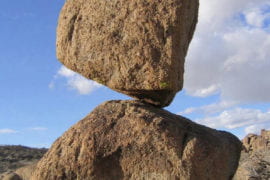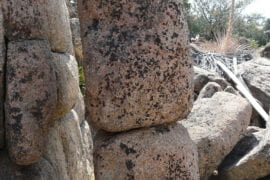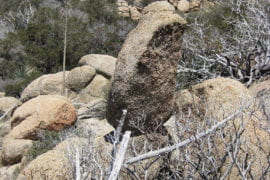Precariously balanced rocks provide clues for unearthing underground fault connections
Stacked in gravity-defying arrangements in the western San Bernardino Mountains, near the San Andreas Fault, granite boulders that should have been toppled by earthquakes long ago resolutely remain. In exploring why these rocks still stand, researchers have uncovered connections between Southern California’s San Jacinto and San Andreas faults that could change how the region plans for future earthquakes.

Irvine, Calif., Aug. 4, 2015 – Stacked in gravity-defying arrangements in the western San Bernardino Mountains, near the San Andreas Fault, granite boulders that should have been toppled by earthquakes long ago resolutely remain. In exploring why these rocks still stand, researchers have uncovered connections between Southern California’s San Jacinto and San Andreas faults that could change how the region plans for future earthquakes.
In a study to be published online Aug. 5 in Seismological Research Letters, Lisa Grant Ludwig, professor of public health at the University of California, Irvine, and colleagues write that the precariously balanced rocks have survived because interaction between the faults has weakened earthquake ground shaking near them.
One such interaction, according to the researchers, might be a rupture that began on the San Andreas Fault but then jumped over to the San Jacinto Fault, near the Cajon Pass. “These faults influence each other, and it looks like sometimes they have probably ruptured together in the past,” Grant Ludwig said. “We can’t say so for sure, but that’s what our data point toward, and it’s an important possibility that we should think about in doing our earthquake planning.”
The Cajon Pass, she noted, is the site of “some very crucial lifeline infrastructure, like I-15, and we should be considering the chance that there might be broader disruptions in that area.”
Most of the earthquake planning scenarios that engineers and others use to guide the design of buildings, aqueducts and other important infrastructure only account for the consequences of ruptures along one fault, she said.
“This paper suggests that we might consider the impact of a rupture that involves both the San Jacinto and San Andreas faults, which has the potential to affect more people than just the San Andreas or just the San Jacinto,” Grant Ludwig said.
She and her colleagues examined 36 of these perilously arranged boulders near Silverwood Lake and Grass Valley that are only 7 to 10 kilometers from the San Andreas and San Jacinto faults. They’re at least 10,000 years old and should have experienced ground shaking from 50 to 100 large, surface-rupturing earthquakes over that time.
Scientists gauge the fragility of these rocks by studying their geometry and conducting field tests such as tilt analyses, in which they put a pulley on a precariously balanced boulder and determine the force required to “tilt it to the point where, if you let it go, it will fall under the influence of gravity,” Grant Ludwig explained.
The researchers report this force as a measure of acceleration. Just as a person in the passenger seat of a car tilts back when the driver steps on the gas pedal, the delicately balanced rocks tilt in response to the ground accelerating beneath them due to an earthquake.
Grant Ludwig and colleagues compared the fragility of the piled-up rocks with the expected ground acceleration in three earthquake scenarios created by the U.S. Geological Survey’s ShakeMap program: a magnitude-7.8 rupture of the southern San Andreas Fault, a magnitude-7.4 San Andreas quake near San Bernardino, and the magnitude-7.9 Fort Tejon temblor in 1857.
According to these scenarios – and national seismic hazard maps for the area – the 36 precariously balanced boulders should have toppled long ago. “It was a real scientific puzzle, a real head-scratcher,” Grant Ludwig said. “How can you have these rocks right next to the San Andreas Fault? It’s an interesting scientific question, but it also has practical implications, because we want our seismic hazard maps to be as good as possible.”
After a decade of investigating many potential explanations, the researchers concluded that only interaction between the San Jacinto and San Andreas faults could have produced the kind of rupture pattern that would preserve the area’s precariously stacked rocks.
Recognizing this interaction could change earthquake planning scenarios for the area, Grant Ludwig concluded.
“The San Jacinto Fault has been very seismically active; it’s produced a lot of earthquakes during [recorded history]. And the southern San Andreas Fault has not; it’s been pretty quiet since 1857,” she said. “This brings up the question of whether we might have an earthquake on the San Jacinto that triggers one on the southern San Andreas, or vice versa.”
Grant Ludwig’s co-authors on the paper are James N. Brune and Richard J. Brune of the University of Nevada, Reno; Abdolrasool Anooshehpoor of the U.S. Nuclear Regulatory Commission; Matthew D. Purvance of the Itasca Consulting Group; and Julian C. Lozos of Stanford University.
About the University of California, Irvine: Currently celebrating its 50th anniversary, UCI is the youngest member of the prestigious Association of American Universities. The campus has produced three Nobel laureates and is known for its academic achievement, premier research, innovation and anteater mascot. Led by Chancellor Howard Gillman, UCI has more than 30,000 students and offers 192 degree programs. It’s located in one of the world’s safest and most economically vibrant communities and is Orange County’s second-largest employer, contributing $4.8 billion annually to the local economy. For more on UCI, visit www.uci.edu.
About the Seismological Society of America: The SSA is an international scientific society devoted to the advancement of seismology and its applications in understanding and mitigating earthquake hazards and in imaging the structure of the Earth. Founded in 1906 in San Francisco, the society now has members throughout the world representing a variety of technical interests: seismologists and other geophysicists, geologists, engineers, insurers, and policymakers in preparedness and safety. It publishes Seismological Research Letters. For more on the SSA, visit www.seismosoc.org.
Media access: Radio programs/stations may, for a fee, use an on-campus ISDN line to interview UC Irvine faculty and experts, subject to availability and university approval. For more UC Irvine news, visit wp.communications.uci.edu. Additional resources for journalists may be found at communications.uci.edu/for-journalists.



